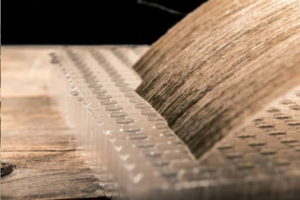The Lina electric vehicle, developed by TU/Ecomotive (the student team of Eindhoven University of Technology) employs a combination of a bio-based composite and bioplastics to create a lightweight chassis.
The bio-based composite is made from flax, a plant that can be grown in the any moderate climate, and polylactic acid (PLA) from NatureWorks as the matrix resin.
Further, EconCore’s technology for cost-effective, continuous production of thermoplastic honeycomb materials yielded the bioplastic honeycomb, also based on PLA.
The honeycomb core made of PLA – 100% biodegradable resin derived from sugar beets – is placed between two flax fiber composite sheets to deliver a sandwich panel effect: high stiffness and strength at minimal weight.
The bio-composite shows strength/weight ratio similar to that of glass fiber.
According to TU/Ecomotive, the concept has the potential to drastically reduce the carbon footprint compared to other lightweight materials used in the industry. The drivetrain of Lina is electric.
Power is supplied by modular battery packs, giving a power output of 8 kW using 2 DC-motors.
This allows Lina to reach a top speed of 80 km/h.
To complement Lina’s sustainability, she is equipped with several high-tech features.
For example, near field communication (NFC) technology implemented in her doors is used to detect and recognize different users, making the vehicle highly suited for car-sharing platforms.



